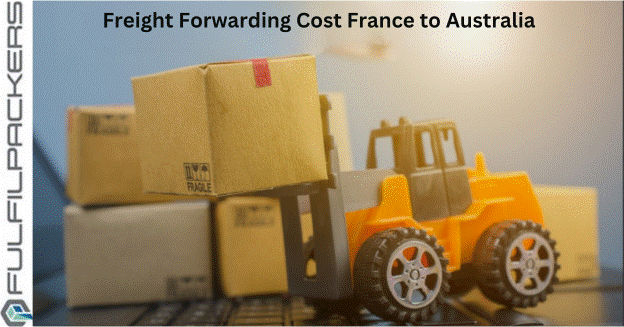Curious about how much it really costs to ship goods from France to Australia? Let’s break down the key factors that influence freight forwarding costs and help you plan your next international shipment

Freight Forwarding Costs France to Australia
The cost of freight forwarder France to Australia depends on factors like shipment size, transport method, and added services. Freight broker insurance cost is an additional expense, based on the value of the goods. Lastly, the Australia forwarding service cost varies depending on whether you choose air or sea freight, so comparing different providers is key to finding the best deal.
Breakdown of Freight Forwarding Costs
Transportation Fees
Transportation fees form the largest portion of freight forwarding expenses. These include the base costs for moving goods via air or sea and vary depending on the shipping route, carrier, and transit method. Efficient route selection and carrier negotiation can help minimize these fees.
Customs Duties and Taxes
Goods entering Australia are subject to customs duties, GST, and other applicable taxes. These costs are calculated based on the type, value, and origin of the goods. A freight forwarder experienced in customs regulations can help you navigate these charges effectively.
Additional Fees
In addition to transportation and customs charges, there may be fees for insurance, documentation, packaging, and storage. While these are often overlooked, they can significantly increase the total cost if not accounted for during the planning stage.
Air Freight vs. Sea Freight
Cost Comparison: Air vs. Sea Freight
Air freight is faster but can be up to five times more expensive than sea freight, depending on the weight and size of the shipment. Sea freight is more suitable for larger shipments and is often the better choice for businesses looking to reduce their shipping costs.
Time and Reliability Considerations
Air freight offers faster delivery times, usually between 3 to 7 days, while sea freight can take between 20 to 40 days, depending on the route and shipping provider. When timing is crucial, air freight is the way to go, but sea freight remains the most economical option for larger, non-urgent shipments.
Environmental Impact of Each Shipping Method
Sea freight tends to have a lower carbon footprint compared to air freight, making it a more sustainable choice. If environmental concerns are important to your business, sea freight could be a better option.
Hidden Costs to Watch Out For
Packaging and Handling Fees
Some freight forwarders charge extra for packaging and handling services. These costs can add up, especially if you’re shipping fragile or oversized items.
Terminal Handling Charges
Terminal handling charges (THC) are applied for goods that need to be moved within ports or airports. Depending on the freight forwarder, these charges can vary and should be considered when estimating overall shipping costs.
Port Congestion Surcharges
If ports are congested, you may encounter additional charges for delays or extended storage times. These are often unavoidable, but being aware of these potential fees can help you prepare.
How to Reduce Freight Forwarding Costs

Selecting the Right Shipping Option
Choosing the most cost-effective shipping method is essential to managing freight forwarding costs. For larger shipments, sea freight is often the most economical choice, while air freight should be reserved for smaller, time-sensitive goods.
Consolidating Shipments
Consolidating shipments with other businesses or clients can help reduce costs. By sharing container space, you can lower the overall cost per kilogram.
Working with Reliable Freight Forwarders
Partnering with experienced freight forwarders can help you optimize your shipping costs. They can offer advice on the best shipping routes, handle negotiations with carriers, and ensure your goods clear customs efficiently.
Leveraging Technology for Cost Savings
Many freight forwarders now offer digital platforms that allow you to track shipments, compare prices, and optimize shipping routes. Using these tools can help you save both time and money.
Top Tips for Choosing a Freight Forwarder
Evaluating Experience and Reputation
Make sure to choose a freight forwarder with experience in shipping to Australia from France. Look for reviews and testimonials to gauge their reliability and reputation.
Understanding Service Offerings
Freight forwarders offer various services, including full container load (FCL), less than container load (LCL), and air freight. Understanding these services can help you choose the best option for your needs.
Importance of Transparent Pricing
Make sure the freight forwarder provides a clear breakdown of costs, including all hidden charges. Transparent pricing ensures that there are no surprises when the final bill arrives.
Freight Forwarding Costs (Various Cities)
| Freight Forwarding Route | Average Cost (USD) | Description |
|---|---|---|
USA to Australia Freight Forwarding Cost | $5.00 per kg | Express shipping is cost-effective for packages up to 150 kg. |
China to Australia Freight Forwarding Cost | $3.53 – $6.70 per kg | Air freight is faster and reliable; sea freight is cost-effective for bulk goods. |
UK to Australia Freight Forwarding Cost | $6.35 per kg (express) | Cheapest for packages under 150 kg, with options for both air and sea freight. |
France to Australia Freight Forwarding Cost | $3.00 – $7.00 per kg | Costs influenced by fuel and labor rates; both air and sea freight options. |
Air Freight UK to Australia Freight Forwarding Cost | $5.09 per kg | Fast and reliable; typically for smaller or high-value shipments. |
India to Australia Freight Forwarding Cost | $1.20 – $4.50 per kg | Sea freight is ideal for large shipments, offering the best value for bulk goods. |
Germany to Australia Freight Forwarding Cost | $32.71 per package | Affordable for parcels; reliable for various types of goods. |
UAE to Australia Freight Forwarding Cost | $3.00 – $7.50 per kg | Based on average container weight and shipping size; typically for sea freight. |
New Zealand to Australia Freight Forwarding Cost | $3.00 – $6.00 per kg | Best for urgent shipments via air freight, or cost-effective for sea freight. |
Conclusion

Freight forwarding from France to Australia involves a wide range of costs, from transportation fees to customs duties and hidden charges. Understanding these costs and selecting the right shipping method and freight forwarder can help you save money and ensure a smooth shipping process. By considering factors like container size, shipping mode, and additional fees, you can make the best decision for your shipment.
FAQs
What is the cheapest way to ship from France to Australia?
Sea freight is generally the cheapest option, especially for larger shipments.
Is sea freight always cheaper than air freight?
Yes, sea freight is typically more cost-effective than air freight, especially for larger shipments.
How can I find a reliable freight forwarder?
Look for experienced freight forwarders with good reviews, competitive rates, and transparent pricing.
Are there any hidden costs in freight forwarding?
Yes, there may be packaging, handling, and port congestion charges. It’s important to ask for a full breakdown of fees from your freight forwarder.


